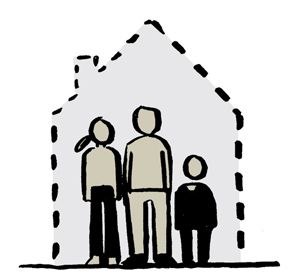Housing costs push 300,000 into poverty

The latest data released from the CSO indicate that 13.2 per cent of the population, more than 660,000 people, were at risk of poverty in 2020. But the cost of accommodation is not included in these calculations. When rent and mortgage interest payments are taken into account, this number jumps to 952,185 – almost one in every five of the population. The impact is particularly severe on children, with more than 93,000 more children living in households at risk of poverty when rent and mortgage interest costs are factored in, bringing the total to almost 300,000 children.
Renters hit hardest
It won’t be a surprise to most renters that the spiraling cost of rent in the past decade has had a significant impact on their poverty risk. Of the more than 1.4 million people living in rented or rent-free accommodation in 2020, almost one in three – some 400,000 people, were at risk of poverty, compared to just 7.1 per cent of those living in owner occupied homes (just over 250,000 people).
When the cost of rent or mortgage interest is factored in, the rate of poverty risk amongst renters jumps from 27.6 per cent to a staggering 44.7 per cent – more than two in five. This amounts to almost an additional 250,000 people, bringing the total number of renters at risk of poverty to 645,160 when the cost of rent is included.
One Parent Families and Older Households most at risk
One parent family households are most at risk of poverty, with more than three of every ten living below the poverty line. However, once housing costs are accounted for, exactly half of all one parent family households are at risk of poverty. This compares to just over 17 per cent of two parent family households.
As the Irish population is increasingly living in the private rented sector or making mortgage payments on their homes post-retirement age, it is unfortunately not surprising that the rate of older people (aged 65 and above) living below the poverty line increases from 15.8 per cent to 25.4 per cent – more than one in every four.
Due to housing costs, almost 60,000 people aged 65 and above are living below the poverty line.
The Working Poor
Paid employment should secure a decent standard of living. However, in 2020, more than 130,000 people with jobs were in poverty. A further 73,000 people with jobs are pushed into poverty once they have paid for the roof over their heads.
For more than 200,000 people in Ireland, a job provides no guarantee of even a basic standard of living.
The Urban / Rural Divide
The difference in housing costs in urban versus rural areas is also evidenced in the latest data. 13.5 per cent of people in urban areas are living below the poverty line compared to 12.5 per cent in rural areas. However, once the cost of providing a roof over your head is factored in, the poverty rate in urban areas increases to more than 20 per cent, compared to an increase to 16.4 per cent in rural areas.
Affordability is Critical
Providing a home for you and your family shouldn’t push you into poverty. Addressing affordability of the home, be it in rent or mortgage payments, must be a key priority for Government.
To do this, the Government introduced the Affordable Housing Act this year. However, this Act continues to rely heavily on demand-side subsidies which only serve to increase house prices, rather than make them truly affordable. Artificially increasing a buyer’s ability to purchase a home through the Shared Equity Scheme does not make that home affordable. It sustains a profit-driven market at the expense of buyers. Furthermore, the Shared Equity Scheme targets the same profile as the previous Government’s Help to Buy Scheme – first time buyers purchasing newly-built properties. The Help to Buy Scheme has been proven, not only by Social Justice Ireland, but by the Parliamentary Budget Office to disproportionately favour higher earners and sustain high property prices.
Increasing the Right Supply
We also need to increase the supply of new homes by an estimated 27,000 to 35,000 per year to take account of new household formation and pent-up demand. Of course, increasing the supply of housing is not of itself going to solve the housing crisis or make housing more affordable. An increase in supply does not necessarily equate to a reduction in prices. Supply must be at the right price points. The wide availability of cheap credit has been more closely linked with affordability and house price increase than supply by commentators both in Ireland and the UK. Robust credit regulation, supply of the right homes in the right location at the right price, and supports to address inequalities inherent in the housing systems which sees greater supply in the commuter belts rather than where housing is actually needed (in cities and, if rural development were to be a priority, in rural towns).
Social Housing is part of the solution
The provision of social housing must be prioritised with homes provided by Local Authorities or Approved Housing Bodies. This would free up properties in the private rented sector for use by households who wish to rent privately at an affordable price, and provide long-term, sustainable social housing to social housing tenants.
Ireland has had a persistent housing crisis for more than a decade. A crisis that drives many of those lucky enough to have homes into poverty. This cannot be ignored any longer.